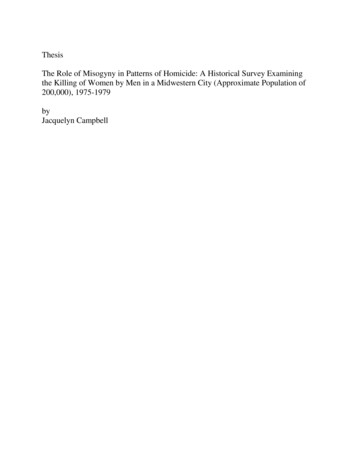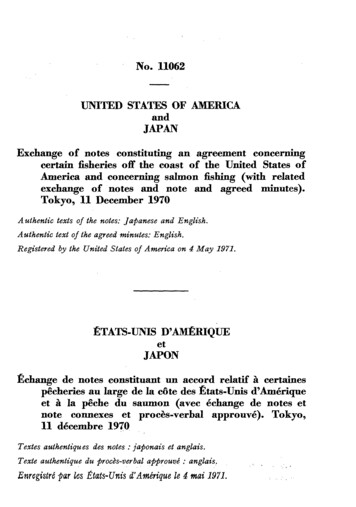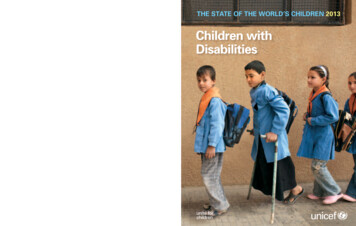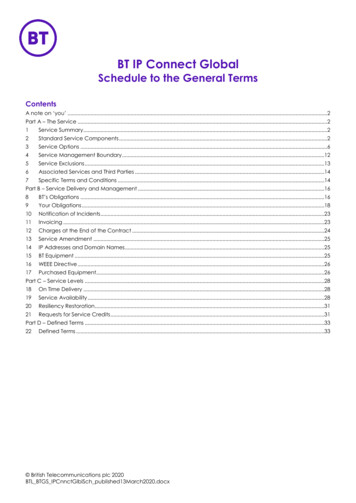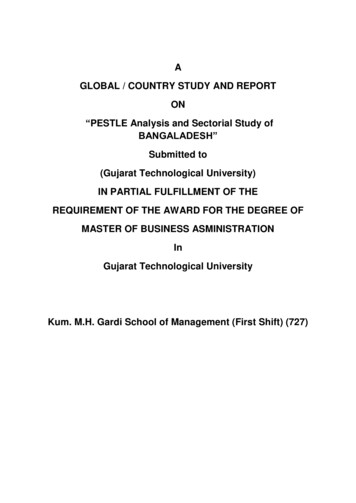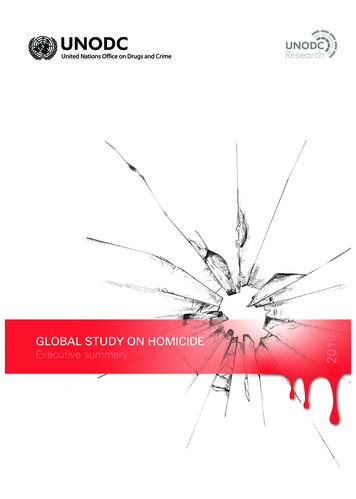
Transcription
Executive summary2019GLOBAL STUDY ON HOMICIDE
UNITED NATIONS OFFICE ON DRUGS AND CRIMEViennaGLOBAL STUDY ON HOMICIDEExecutive summary2019
United Nations, July 2019. All rights reserved worldwide.This publication may be reproduced in whole or in part and in any formfor educational or non-profit purposes without special permission fromthe copyright holder, provided acknowledgement of the source is made.The United Nations Office on Drugs and Crime (UNODC) would appreciatereceiving a copy of any publication that uses this publication as a source.Suggested citation: UNODC, Global Study on Homicide 2019 (Vienna, 2019)No use of this publication may be made for resale or any other commercialpurpose whatsoever without prior permission in writing from UNODC.Applications for such permission, with a statement of purpose and intent of thereproduction, should be addressed to the Research and Trend Analysis Branch of UNODC.DISCLAIMERThe content of this publication does not necessarily reflect the views orpolicies of UNODC or contributory organizations, nor does it imply any endorsement.Comments on the report are welcome and can be sent to:Division for Policy Analysis and Public AffairsUnited Nations Office on Drugs and CrimePO Box 5001400 ViennaAustriaTel: ( 43) 1 26060 0Fax: ( 43) 1 26060 5827
Executive summaryPREFACEThe Global Study on Homicide is a search for solutions. By bringing together the available data, the UnitedNations Office on Drugs and Crime seeks to shed light on different phenomena, from lethal gang violenceand the role of firearms to links with inequalities and gender-related killings, and in this way supporttargeted action. I hope that the research and analysis contained in the study are used in this spirit – not todesignate “murder capitals” but to learn, understand and strengthen prevention.Criminal activity is responsible for many more deaths worldwide than armed conflict and terrorismcombined. Unless the international community takes decisive steps, targets under SustainableDevelopment Goal 16 to significantly reduce all forms of violence and related death rates by 2030 will notbe met.The Americas continue to report high homicide rates. Young men are especially at risk, with a homiciderate for men aged 18 to 19 estimated at 46 per 100,000 – far higher than the risk faced by their peers inother regions. Firearms are also involved far more often in homicides in the Americas than in other partsof the world.By contrast, Europe has seen a decline in the homicide rate by 63 per cent since 2002 and by 38 per centsince 1990. The rate in Asia has fallen by 36 per cent since 1990. Data collection overall has improved sincethe previous Global Study on Homicide, but there remain serious gaps in the availability of reliable data forAfrican countries. There are also indications that homicide is underreported in the official statistics inPacific countries.This study offers particular insights into the gender-related killing of women and girls. “Femicide”represents just a small percentage of the overall number of homicides, but our analysis indicates that thedrivers of this type of lethal violence require tailored responses. Killings carried out by intimate partnersare rarely spontaneous or random, and should be examined as an extreme act on a continuum of genderrelated violence that remains underreported and too often ignored.The Global Study on Homicide 2019 also documents successes in preventing and addressing lethal violence.In particular, the study offers examples of effective community-based interventions in settings afflicted byviolence, gangs and organized crime. These accounts show that with targeted interventions backed bysustained engagement and trust between communities and law enforcement, bringing down homiciderates is possible.Yury FedotovExecutive Director, United Nations Office on Drugs and Crime1
Executive summaryACKNOWLEDGEMENTSThe Global Study on Homicide 2019 was prepared by the Research and Trend Analysis Branch, Division forPolicy Analysis and Public Affairs, United Nations Office on Drugs and Crime, under the supervision of JeanLuc Lemahieu, Director of the Division, and Angela Me, Chief of the Research and Trend Analysis Branch.General coordination and content overviewAngela MeAndrada-Maria FilipAnalysis and draftingErik AldaJoseph BoyleTommaso ComunaleJonathan GibbonsMichael JandlAlexander KampradKristiina KangaspuntaTheodore LeggettMarieke LiemHanneke SchönbergerAntoine VellaIrmgard ZeilerEditingLuis SundkvistData management and estimates productionStefanie MavrakouOualid AkakziaBeatriz de Moraes RodriguesKaren AvanesyanLea Ruiz TaladrizEnrico BisognoUmidjon RakhmonberdievDiana CameriniMateus Rennó SantosSarika DewanVania SalgadinhoSalomé Flores SierraFatma UshevaSmriti GanapathiLorenzo VitaKirsty MacAulayCover design and productionAnja KorenblikSuzanne KunnenKristina KuttnigFabian RettenbacherAdministrative supportIulia LazarReview and commentsThe Global Study on Homicide 2019 benefited from the expertise of, and invaluable contributions from,UNODC colleagues in all divisions and field offices. Particular thanks are owed to the Justice Section of theDivision for Operations. The Research and Trend Analysis Branch also acknowledges the helpful feedbackprovided by UNICEF and the expert contributions of:Murray AckmannKatherine AguirreMyrna DawsonManuel EisnerRenata GianniniAnine KrieglerRobert MuggahTapio Lappi-SeppäläMartti LehtiThe research for this booklet was made possible by the generous contribution of Sweden.3
Executive summaryCONTENTSPreface . 1Acknowledgements . 3Introduction to the concept of intentional homicide . 7Executive summary . 111. Latest trends . 112. Victims and perpetrators . 233. Reasons for killing and drivers of homicide . 26Conclusions and policy implications . 355
Executive summaryINTRODUCTION TO THE CONCEPT OFINTENTIONAL HOMICIDEIntentional homicide is the ultimate crime and has ripple effects that go far beyond the original loss ofhuman life. For homicide also blights the lives of the victim’s family and community, who may therefore bedescribed as “secondary victims”. It creates a violent environment that has a negative impact on society,the economy and government institutions. Homicide is not limited to people living on the margins ofsociety; rather, it can affect all people, irrespective of their age, sex, ethnicity and socioeconomicbackground. Since homicide has an impact on people from all walks of life, all facets of homicide need tobe analysed.The study of intentional homicide is relevant not only because of the gravity of the offence, but alsobecause intentional homicide is one of the most measurable and comparable indicators for monitoringviolent deaths. Because of its lethal outcome, homicide is particularly amenable to temporal (longitudinal)and cross-national (geographic) comparisons: it tends to have greater definitional specificity than othercrimes in different historical and national contexts.1 Homicide is an act that meets with virtually universalcondemnation, and homicide statistics are accordingly considered to be relatively reliable and valid – bothat the national level and for longitudinal and cross-national comparisons. 2 As a readily measurableindicator, homicide is both a reasonable proxy for violent crime and a robust indicator of levels of violencewithin States.3When attempting to measure the scale of homicide it is important to have a clear definition that providesguidance on which specific acts of killing are to be considered intentional homicide. Certain contextualchallenges may arise when intentional killings have to be disentangled from other killings during situationsof collective violence, such as armed conflict or civil unrest.The International Classification of Crime for Statistical Purposes (ICCS),4 developed by the United NationsOffice on Drugs and Crime (UNODC), provides a framework for the definition and classification of unlawfulkillings, both in conflict and non-conflict situations. Homicide is defined in ICCS as “unlawful death inflictedupon a person with the intent to cause death or serious injury”. This statistical definition contains threeelements that characterize the killing of a person as “intentional homicide”:1. The killing of a person by another person (objective element)2. The intent of the perpetrator to kill or seriously injure the victim (subjective element)3. The unlawfulness of the killing (legal element)For recording purposes, all killings that meet the criteria listed above are to be considered intentionalhomicides, irrespective of definitions provided by national legislations or practices. Killings as a result ofterrorist activities are also to be classified as a form of intentional homicide.ICCS also provides a statistical framework for disentangling homicides from other conflict-related deaths.When applying this framework and aggregating the various forms of lethal victimization perpetratedglobally, it transpires that a relatively small share is attributable to conflict deaths. The greatest burden oflethal victimization ultimately stems from homicidal violence.Among the various forms of violent death, the core element of intentional homicide is the complete liabilityof the perpetrator, which differentiates it from killings related to armed conflict and war, self-inflicteddeath (suicide), killings due to legal interventions and justifiable homicide (such as self-defence), and fromdeaths caused by reckless or negligent actions, which were not intended to take a human life(non-intentional homicide).1Johnson, B. D., Van Wingerden, S. and Nieuwbeerta, P., “Sentencing homicide offenders in the Netherlands: offender, victim, andsituational influences in criminal punishment”, Criminology, vol. 48, No. 4 (November 2010), pp. 981–1018.2Marshall, I. H. and Summers, D. L., “Contemporary differences in rates and trends of homicide among European nations”, Handbook ofEuropean Homicide Research: Patterns, Explanations, and Country Studies (New York, Springer, 2012).3UNODC, Global Study on Homicide 2013 (United Nations publication, Sales No. 14.IV.1).4UNODC, International Classification of Crime for Statistical Purposes (ICCS): Version 1.0 (Vienna, 2015).7
Global study on homicide 2019Source: UNODC.Various circumstances, motivations and relationships can act as driving forces of homicide, and they areoften overlapping and multifaceted. Although it can sometimes be difficult to distinguish between thedifferent elements that drive homicide, the Global Study on Homicide uses a classification of homicide intothree main typologies: homicide related to interpersonal conflict, homicide related to criminal activitiesand homicide related to sociopolitical agendas.By improving understanding of the underlying patterns and trends related to homicide at the global,regional and national levels, this study can support governments in their efforts to address root causes andenhance public health and criminal justice responses to violence. This aim is also enshrined in theSustainable Development Goals, target 16.1 of which reads: “Significantly reduce all forms of violence andrelated death rates everywhere”, while the associated indicator 16.1.1 is defined as: “Number of victims ofintentional homicide per 100,000 population, by sex and age”. A summary of the interplay between theSustainable Development Goals and homicidal violence is provided below.Summary of the interplay between homicidal violenceand the Sustainable Development GoalsPoverty is a risk factor associated with violent crime and victimization at both theindividual and national level. At the individual level, people may resort to violent crimeas a means of survival. At the national level, a shrinking economy may be accompaniedby reduced investment in law enforcement systems, leading to a state of lawlessness, inwhich citizens are more exposed to violent crime. High levels of violence can also driveproperty values down and undermine business growth, thus exacerbating poverty,which can in turn lead to further violence. Large-scale violence hinders efforts to reducepoverty.Target 1.4 access to basic services, ownership and control over land Insecure land tenure and access to land in the context of an inadequate legal frameworkthat does not enforce individual property rights can create disputes and produce a highlevel of violence.Homicide is among the leading causes of death among young people (aged 15 to 29) insome countries and, in general, results in millions of years of life being lost annually.High levels of violence, including homicide, put a heavy strain on public health services,particularly in developing countries where resources are already scarce. Moreover,mental health issues are more common in countries with comparatively high levels oflethal violence, which places a further burden on public health services. On the whole,a high level of violence shortens life expectancy significantly.8
Executive summaryHigh levels of homicide and violence in general can have a negative impact on schoolingand educational outcomes. Because of the diminished economic opportunities faced byyoung people who fail to receive a high-quality education, they are more likely to engagein delinquent and violent behaviour, which can ultimately even lure them into organizedcriminal structures. Education in both formal and informal settings is a key element inreducing violence because it helps to strengthen key life skills that build resilience tocrime and victimization, and also to increase employment opportunities, which act as aprotective factor against crime and violence.High and persistent levels of violence are a threat to achieving gender equality. Societieswith pronounced gender inequality tend to be characterized by higher levels ofinterpersonal violence against women, including lethal violence. Conversely, theempowerment of women has been shown to be accompanied by a decrease in the levelof intimate partner violence. Greater autonomy and independence, when alsocombined with a higher social status, help to protect women from the risk of homicide.Lethal violence results in both direct and indirect monetary costs for society and canimpede economic growth. Sustained economic growth can improve economicconditions and access to health and social services, and thus reduce some of the riskfactors associated with a higher level of violence. An increase in the proportion of youngpeople who are not economically active (not in employment, education or training) islinked to an increase in levels of homicide.Countries with greater income inequality are more likely to have higher homicide ratesthan countries with less inequality. Economic developments that exacerbate incomeinequality both within and between countries can foster criminal violence. Sociopoliticalinequality, notably unequal access to resources, is known to be a root cause of violentbehaviour. Marginalized people are more likely to become victims of violence, whichmakes their efforts to enjoy equal rights even more arduous. Unequal access toeducation and health services has also been found to be linked to higher levels ofhomicide, as have higher infant mortality rates.Target 10.7 facilitate orderly, safe, and responsible migration and mobility ofpeople There is some evidence pointing to a zero or negative correlation between homicide andmigration at the macro level, whereas other findings suggest that they are positivelycorrelated. Migration may therefore increase or decrease levels of crime depending onspecific national and subnational contexts, which in turn may either hinder or facilitatethe integration of migrants in host countries. For example, migration can sometimesreduce aggregate levels of crime, including violent crime, by increasing labour marketopportunities for both native- and foreign-born populationsAlthough cities provide opportunities, jobs and services for their inhabitants, they arealso rife with direct and indirect risks of violence. A poorly managed high populationdensity, high levels of income inequality, high prevalence of mental illness and drugdependence, the potential for anonymity, and the existence of gangs and organizedcrime groups are among the factors that increase those risks in urban areas. On theother hand, cities can offer protection against violence because they tend to be moreaffluent, have higher policing levels and provide better access to medical services andeducational facilities than non-urban areas. Such protective factors can offset the riskfactors mentioned earlier, but it is worth emphasizing that every city, and indeed everyneighbourhood, has unique characteristics that shape and influence homicide rates.9
Global study on homicide 2019Conflict over resources has always been a major driver of violence, both at interpersonaland national level. Climate scientists estimate that changes associated with the globalincrease in temperatures and other forms of environmental degradation will greatlyexacerbate violent conflicts in the future. High temperatures have been independentlyassociated with violent aggression, but potentially more important are the effects thatclimate change could have on the economy and migration.There is a clear link between prevalence of the rule of law and levels of homicidalviolence. Strengthening the rule of law and making criminal justice systems fairer andmore effective can prevent violence by reducing recidivism, serving as a deterrent toviolent behaviour, and promoting trust in public authorities and values that increasesocial cohesion. A high level of homicide can place an additional burden on criminaljustice systems with already limited resources, and is one of the factors behind prisonovercrowding, depending on specific national contexts. Measures that increase theefficiency of criminal justice systems – notably by improving access to legal aid,eliminating inhuman prison conditions, avoiding excessive and lengthy pre-trialdetention, and reducing the degree of impunity of perpetrators – can bring downhomicide rates. Conversely, a low homicide rate can help maintain effective and faircriminal justice institutions.10
Executive summaryEXECUTIVE SUMMARY1. Latest trendsHomicide rates are falling, but not quickly enough to achieve the relevant targetsunder Sustainable Development Goal 16The overall risk of suffering a violent death as a result of intentional homicide has been decliningsteadily for a quarter of a century. In 2017, there were 6.1 homicide victims per 100,000population worldwide, compared with a rate of 7.4 in 1993. While gaps still remain in terms ofthe quality and availability of national data, these estimates are based on the latest and mostcomprehensive data submitted by Member States to UNODC up to 2017.Homicide rate (victims of intentional homicide per 100,000 population), by region, ope3.0Oceania2.805101520Victims of intentional homicide per 100,000 populationSource: Estimates based on UNODC homicide statistics.Note: Error bars represent the regional/global sum of lower and upper estimates at the national level.However, the global homicide rate is calculated as a proportion of the population and it has declined onlybecause the global population has risen. This means that the increase in the global population has beenhigher than the increase in the overall number of homicide victims recorded worldwide. The overallnumber of people killed in homicides increased from 362,000 in 1990 to 464,000 in 2017.Total number of homicide victims, by region, 000120,000160,000Source: Estimates based on UNODC homicide statistics.Note: Error bars represent the regional sum of lower and upper estimates at the national level.11200,000240,000
Global study on homicide 2019Crime kills far more people than armed conflictCriminal activity causes many more deaths than conflicts and terrorism combined. The 464,000 victims ofhomicide surpass by far the 89,000 killed in armed conflicts and the 26,000 fatal victims of terrorist violencein 2017. Organized crime alone can be a significant source of lethal violence; since the start of the twentyfirst century, organized crime has resulted in roughly the same number of killings as all armed conflictsacross the world combined. It is estimated that an average of roughly 65,000 killings every year wererelated to organized crime and gangs over the period 2000–2017, and that up to 19 per cent of allhomicides recorded globally in 2017 were related to organized crime and gangs.Organized crime kills as many people as all armed conflicts combinedBetween 2015 and 2017 the total number of homicide victims worldwide increased by 4 per cent, or around19,000 victims. If this trend continues, target 16.1 (“significantly reduce all forms of violence and relateddeath rates everywhere”) under Sustainable Development Goal 16, which was set in 2015, will not be metby 2030.12
Executive summaryCurrent trend indicates that sustainable Development Goaltarget 16.1may not be reached by 2030Risk of becoming a victim of homicide varies widely according to regionThe 2017 global homicide rate masks dramatic regional variations. Countries in the Americas reported173,000 victims of intentional homicide – 37 per cent of the global total in a region that accounts for only13 per cent of the world’s population. The homicide rate of 17.2 victims per 100,000 population in theAmericas was the highest recorded in the region since reliable records began in 1990. Africa was the onlyother region with a homicide rate exceeding the global average, with 13.0 victims per 100,000 population,or 163,000 victims in total.Homicide rate and population sizeSource: Estimates based on UNODC homicide statistics.By contrast, the homicide rate in Europe was 3.0 per 100,000 population. There were 22,000 homicidevictims in Europe, 5 per cent of the global total in a region accounting for 10 per cent of the globalpopulation. The lowest regional rate of homicide in 2017 was reported in Asia, with 104,000 victimsrepresenting a rate of 2.3 per 100,000 population. Asia, which contains 60 per cent of the global population,accounted for 23 per cent of total homicide victims worldwide.13
Global study on homicide 2019Homicide rate, by country or territory, 2017The boundaries and names shown and the designation used on this map do not imply official endorsement or acceptance by the UnitedNations. Dashed lines represent undetermined boundaries. The dotted line represents approximately the Line of Control in Jammu andKashmir agreed upon by India and Pakistan. The final status of Jammu and Kashmir has not yet been agreed upon by the parties. The finalboundary between the Republic of Sudan and the Republic of South Sudan has not yet been determined.Source: UNODC homicide statistics.Killing of women by intimate partners or family members is risingHomicide victims, by sex and region (rates and counts), 2017Some 87,000 women and girls were intentionally killed in 2017, a decrease from 2012. The share of womenkilled by intimate partners or other family members, however, rose from 47 per cent of all female homicidevictims in 2012 to 58 per cent in 2017, and the overall number who lost their lives to this type of homiciderose from 48,000 victims in 2012 to 50,000 in 2017. The home remains the most dangerous place forwomen, who continue to bear the heaviest burden of lethal victimization as a result of inequality andgender stereotypes.14
Executive summaryAlthough women and girls account for a far smaller share of victims of homicide ingeneral than men, they bear by far the greatest burden of intimate partner/familyrelated homicide, and intimate partner homicide.Number of children killed in homicides has remained stable for a decadeChildren aged 14 years or under make up a small share of the total number of homicide victims recordedworldwide. Thus, in 2017 some 21,540 children in that age group were killed in homicides, which is lessthan 5 per cent of the global total for that year. The trend appears to be broadly stable, with data from theUnited Nations Survey of Crime Trends and Operations of Criminal Justice Systems suggesting that roughly21,000 children in this age group have lost their lives in homicides each year since 2008.Globally, the risk faced by children aged 14 years or under of falling victim to homicide has not changedsignificantly: the homicide rate for girls stood at 0.9 per 100,000 in both 2008 and 2017, while the rate forboys fell from 1.3 in 2008 to 1.2 in 2017.In Europe, the risk faced by children has decreased considerably in recent years – for boys aged 14 or under,the overall rate dropped from 2.0 in 2008 to 1.4 in 2017, while for girls in the same age group it fell from1.2 to 0.8 over the same period. Notably, the homicide rates for both boys and girls aged 0 to 14 yearsrecorded in Europe were higher than the global average.In the Americas, a slight increase in the homicide rate for boys aged 14 and under was recorded – from 1.6in 2008 to 1.7 in 2017. For girls in the same age group, the homicide rate in 2017 was 1.0, the same levelrecorded in 2008.Homicide rate per 100,000population in the correspondingage groupHomicide rate of males aged 0–14 years and 15–29 years, worldwide, 2008–201718.016.014.012.010.08.06.04.02.00.02008 2009 2010 2011 2012 2013 2014 2015 2016 2017Male victims aged 0-14 yearsMale victims aged 15-29 yearsSource: Estimates based on UNODC homicide statistics.15
Global study on homicide 2019Homicide rate per 100,000population in the corresponding agegroupHomicide rate of females aged 0–14 years and 15–29 years, worldwide, 2008–20173.02.52.01.51.00.50.02008 2009 2010 2011 2012 2013 2014 2015 2016 2017Female victims aged 0-14 yearsFemale victims aged 15-29 yearsSource: Estimates based on UNODC homicide statistics.Some cities in the Americas have registered falling homicide rates even thoughnational rates have risenUNODC analysis of trends in 68 cities across 66 countries shows an average 34 per cent drop in homiciderates between 2003 and 2016 in those cities, compared with a 16 per cent decrease in the correspondingnational rates. In the Americas, the difference in trends between urban and national homicide rates is evenmore striking. Over the same period there was an average drop of 29 per cent in the 17 largest cities, whilenational homicide rates rose by 2 per cent. These figures suggest that the increases in homicidal violencereported in some countries in the Americas have happened outside the big cities.Journalists are increasingly targeted outside conflict zonesThe number of journalists killed each year between 2007 and 2017 fluctuated from a low of 46 in 2008 toa high of 124 in 2012, according to estimates by the United Nations Educational, Scientific and CulturalOrganization (UNESCO). The vast majority were local journalists and most of the killings took place incountries experiencing armed conflict. However, more than half of the 80 journalists killed in 2017 losttheir lives in countries not affected by armed conflict as such.16
Executive summaryCity homicide in Central America and South AmericaCities with a population smaller than 250,000 are not displayed on the map. The boundaries and names shown and the designation used onthis map do not imply official endorsement or acceptance by the United Nations.Source: UNODC homicide statistics.Reflecting the recent shifts in war zones, the largest share of killings in 2017 was recorded in Asia and thePacific, which accounted for 40 per cent of the total. In 2016, the most dangerous geographical area forjournalists had been the Arab States, where 34 per cent of that year’s total number of victims lost theirlives. Those States include Iraq, the Syrian Arab Republic and Yemen, all three of which were experiencingarmed conflicts in 2016 and 2017. Overall, the UNESCO figures show that journalists faced a slightly lowerrisk in the period 2015–2017 than they did in the period 2012–2014. Fourteen fewer journalists were killedin the period 2015–2017 than in the earlier three-year period – a drop of 5 per cent. This contrasts withthe situation for aid workers, who faced a slightly increasing risk between the same two periods. Data from17
Global study on homicide 2019the Aid Worker Security Database show that the number of aid workers killed rose by 1 per cent from2012–2014 to 2015–2017.Number of journalists killed, by region, 2012–2016Asia and the Pacific107Central and Eastern Europe17Arab States191Africa73Western Europe and North America17Latin America and the Caribbean125050100150200250Source: UNESCO and University of Oxford, World Trends in Freedom of Expression and Media Development: 2017/2018 Global Report(Paris, UNESCO, 2018).Homicide rates remain high in the Americas even as they plummet elsewhereHomicide rates have b
the economy and government institutions. Homicide is not limited to people living on the margins of society; rather, it can affect all people, irrespective of their age, sex, ethnicity and socioeconomic background. Since homicide has an impact on people from all w
